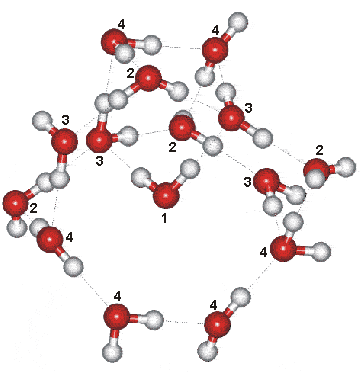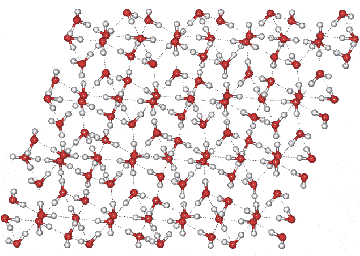
Ice V substructure

Ice-five (ice V) is formed from liquid water at 500 MPa by lowering its temperature to 253 K (see Phase Diagram). Its unit cell, which forms monoclinic crystals (Space group C2/c, 15; Laue class symmetry 2/m), is shown on the right. Ice V contains four-, five-, six-, and eight-membered rings (that is, the opposite sub-structure has two of each) and groups of seven molecules at four different lattice sites (three consisting of two molecules and one of a single molecule) with each experiencing a differing molecular environment. A chain of water molecules (O4), with each forming a corner of two condensed four-membered rings, runs parallel to the a-axis.
Also parallel, run chains of two other alternating sites (O2 and O3), joined together through gaps in the first chain by the smaller number of the fourth type (O1). O4 water molecules are also hydrogen-bonded to the O2 and O3 water molecules but not to the O1 molecules. These latter molecules form hydrogen bonds that penetrate (go through) the 8-membered rings structures.
Ice-five crystal; 2x2x2 unit cells

All molecules form one connected lattice with a density of 1.24 g cm−3 (at 350 MPa where water density = 1.13 g cm−3) [8]. The hydrogen bonding is disordered and continually changing as in hexagonal ice. This disorder gives rise to a zero-point entropy close to 3.435 J mol−1 K−1 [2153]. The crystal has cell dimensions a 9.22 Å, b 7.54 Å, and c 10.35 Å, (90°, 109.2°, 90°, 28 molecules; at atmospheric pressure and 98 K), and a unit cell contains 28 water molecules [359].
Ice-five has triple points with liquid water and ice-three (-16.986 °C, 350.1 MPa), liquid water and ice-six (0.16 °C, 632.4 MPa), ice-two and ice-three (-24.3 °C, 344.3 MPa) and ice-two and ice-six (estimated at -55 °C, 620 MPa). The relative permittivity (dielectric constant) of ice-five is about 144. The Gibbs energy representation for ice V has been reported [3697].
The melting curve for ice-five is given by  MPa [1320]. The experimental 2D IR spectra of D2O isotopically pure ice Ih, ice II, ice V, and ice XIII have been compared [3121]. The near-infrared spectra of ice-five has been compared with that of hexagonal
ice [4189]. The SeaFreeze package allows the computation of the thermodynamic (phase boundaries, density, entropy, specific heat, isothermal bulk modulus, adiabatic bulk modulus, thermal expansivity, chemical potentials) and elastic properties of ice V over the 0-2300 MPa and 220-500K range [3832].
MPa [1320]. The experimental 2D IR spectra of D2O isotopically pure ice Ih, ice II, ice V, and ice XIII have been compared [3121]. The near-infrared spectra of ice-five has been compared with that of hexagonal
ice [4189]. The SeaFreeze package allows the computation of the thermodynamic (phase boundaries, density, entropy, specific heat, isothermal bulk modulus, adiabatic bulk modulus, thermal expansivity, chemical potentials) and elastic properties of ice V over the 0-2300 MPa and 220-500K range [3832].
Note that in this structural diagram the hydrogen bonding is ordered. In contrast, in reality it is random (obeying the 'ice rules': two hydrogen atoms near each oxygen, one hydrogen atom on each O····O bond). As the H-O-H angle does not vary much from that of the isolated molecule, the hydrogen bonds are not straight (although shown so in the figures).
The ordered hydrogen-bonding form of ice V is ice XIII (ice-thirteen).
Interactive Jmol structures are given.
Home | Site Index | Phase Diagram | Ices, introduction | Ice-Ih | Ice-Ic | Ice-Isd | II | III | IV | VI | VII | VIII | IX | X | XI | XII | XIII | XIV | XV | XVI| XVII | XVIII | Amorphous ice | LSBU | Top
This page was established in 2002 and last updated by Martin Chaplin on 12 September, 2021